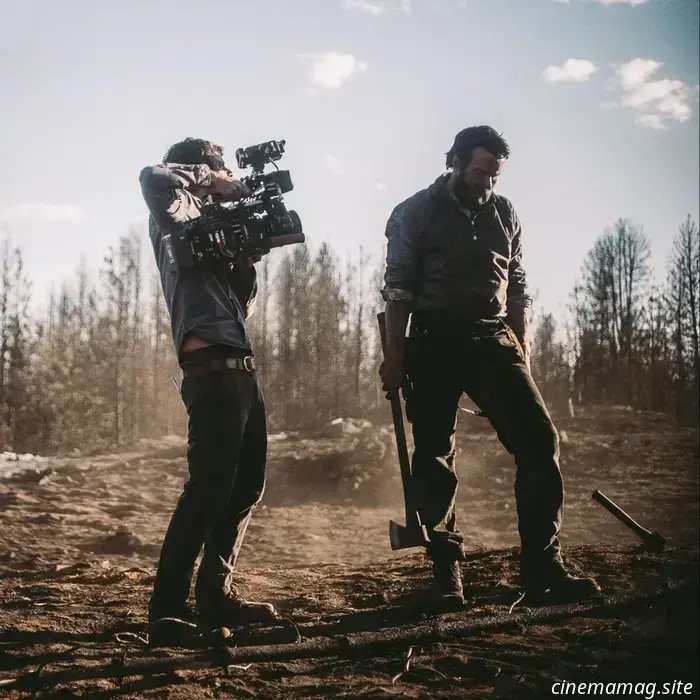
Train Dreams director Clint Bentley discusses natural lighting, narrative shaping, and the real-life influences behind the film.
Through the perspective of wandering logger Robert Granier (Joel Edgerton), "Train Dreams" explores America's evolution from a pioneering landscape to an industrialized nation during the early 20th century. Clint Bentley and Greg Kwedar, long-time collaborators, alternate directing their projects: Kwedar helmed 2016’s "Transpecos" and last year’s "Sing Sing," while "Train Dreams" marks Bentley’s directorial follow-up to 2021’s "Jockey."
Based on a novella by Denis Johnson, this period drama was filmed on location in the Pacific Northwest, capturing an expansive timeline filled with various individuals who briefly cross paths with Granier, leaving lasting impressions, often unknowingly. William H. Macy delivers standout moments as Arn Peeples, a demolition expert who believes that the act of logging 200-year-old trees taints one's soul. Felicity Jones portrays Granier’s wife, Gladys, who yearns for him during his lengthy absences during the logging season. The film presents a Malickian narrative centered on Granier's struggle with the historical significance of a single moment in his life.
Before the film's premiere on Netflix today, I met with Bentley at the London Hotel in West Hollywood, where we discussed the necessity of using digital with natural and practical lighting in the indie production, how Granier was influenced by men in Bentley’s life, and how a notable cowboy sequence emerged from a ticking clock on set that day.
The Film Stage: The ways research manifests on screen can sometimes feel abstract. Do you have concrete examples of how your thorough research influenced what appears on screen? Conversely, research may also lead to intangible insights from simply being in a location and connecting with the locals.
Clint Bentley: Research is such an enigmatic process because it can yield unexpected discoveries by simply visiting different places. Early in the movie, we see a large, 11-foot sturgeon displayed on a pole. This was inspired by a trip I took to the panhandle of Idaho with Greg Kwedar, my co-writer. We visited a small museum in Bonners Ferry that featured photographs of people standing next to these enormous sturgeons that had been caught from local rivers, these prehistoric fish that no longer exist at that size.
I also learned from a book about men who would ride logs down rivers, using long poles to break up logjams. It was an exceedingly hazardous job, and when a worker died, their boots would be nailed to a tree. This concept resonated with me, becoming a powerful image that unexpectedly shapes the film. I could elaborate further, but research consistently sparks ideas that might not have emerged otherwise.
You’ve expressed the high regard you have for Granier and these men. How do you portray these characters respectfully while still showing their humanity? There exists a delicate balance where you might hesitate to subject them to negative experiences because of your affection for them.
It's amusing. It's similar to how you feel about your own children—a deep love makes you want to shield them from harm, but you also recognize that without facing adversity, they won’t grow. The same goes for characters; they must encounter challenges within the narrative so that we can witness their reactions as individuals to those experiences. There’s an ineffable and curious aspect to screenwriting, where you sometimes find yourself surprised by their actions, as peculiar as that may sound.
Will Patton’s narration often fills in gaps regarding Joel’s character, Robert, explaining his thoughts and feelings. Was the narration developed in conjunction with how you collaborated with Joel?
Absolutely. Joel is a unique artist who comprehends the entire process, so he was aware of the narration's presence. It evolved with the film until the final edit, where we aimed to find a balance between moments that naturally required narration and those where we opted for a silent film approach.
That struck me. Many times, even if I removed the narration—almost invariably—it was still visually apparent. For instance, when he’s bathing in a lake after a significant realization, focusing on his hands—this scene was initially laden with narration, which I loved. However, it felt as if it wasn’t fully connecting with the audience. By removing the narration and allowing viewers to simply experience his emotions, the moment deepened significantly.
Joel possesses a distinctive talent for portraying a character who isn’t unintelligent, yet isn’t formally educated either. He embodies a working-class man seeking something more profound in life, conveying this subtly through his expressions and behavior.
That’s part of the character and reminds me of men from my life. My uncle, for example, never pursued higher education but is a deeply reflective person. Occasionally, he shares thoughts that echo Kierkegaard, articulated in his unique style. Education doesn’t always equate to depth. Joel excels at this nuance, and we discussed early on the desire to depict a profound character grappling with emotions and thoughts that run deeply beneath the surface, yet lacking the vocabulary to articulate


Train Dreams director Clint Bentley discusses natural lighting, narrative shaping, and the real-life influences behind the film.
Seen through the perspective of wandering logger Robert Granier (Joel Edgerton), Train Dreams follows America's evolution from a land of pioneers to an industrialized country during the first half of the 20th Century. Clint Bentley and Greg Kwedar, who have been writing partners for a long time, alternate in directing their projects: Kwedar was at the helm for Transpecos in 2016 and Sing Sing last year.

